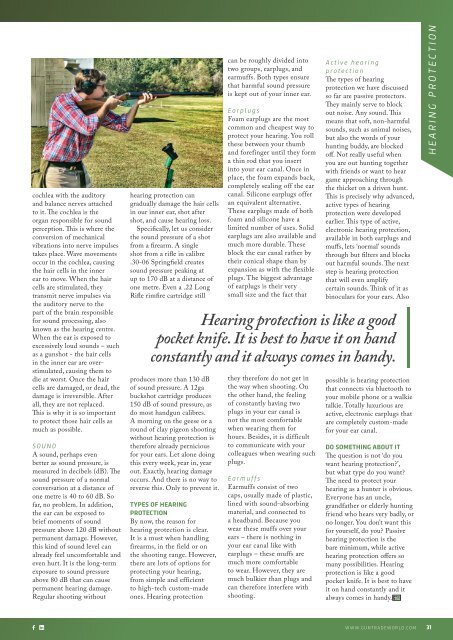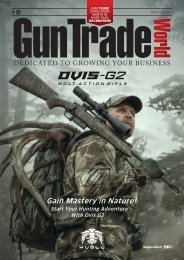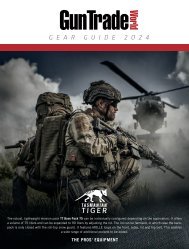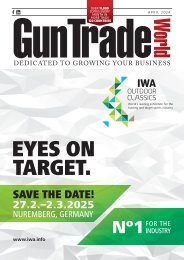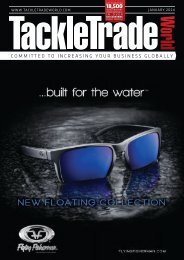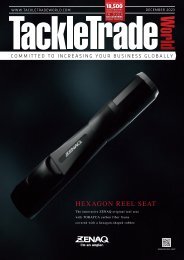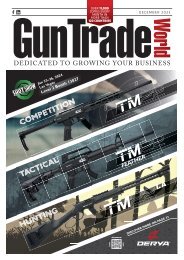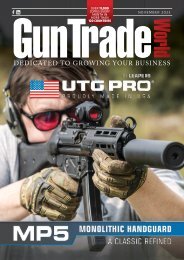Create successful ePaper yourself
Turn your PDF publications into a flip-book with our unique Google optimized e-Paper software.
cochlea with the auditory<br />
and balance nerves attached<br />
to it. The cochlea is the<br />
organ responsible for sound<br />
perception. This is where the<br />
conversion of mechanical<br />
vibrations into nerve impulses<br />
takes place. Wave movements<br />
occur in the cochlea, causing<br />
the hair cells in the inner<br />
ear to move. When the hair<br />
cells are stimulated, they<br />
transmit nerve impulses via<br />
the auditory nerve to the<br />
part of the brain responsible<br />
for sound processing, also<br />
known as the hearing centre.<br />
When the ear is exposed to<br />
excessively loud sounds – such<br />
as a gunshot - the hair cells<br />
in the inner ear are overstimulated,<br />
causing them to<br />
die at worst. Once the hair<br />
cells are damaged, or dead, the<br />
damage is irreversible. After<br />
all, they are not replaced.<br />
This is why it is so important<br />
to protect those hair cells as<br />
much as possible.<br />
SOUND<br />
A sound, perhaps even<br />
better as sound pressure, is<br />
measured in decibels (dB). The<br />
sound pressure of a normal<br />
conversation at a distance of<br />
one metre is 40 to 60 dB. So<br />
far, no problem. In addition,<br />
the ear can be exposed to<br />
brief moments of sound<br />
pressure above 120 dB without<br />
permanent damage. However,<br />
this kind of sound level can<br />
already feel uncomfortable and<br />
even hurt. It is the long-term<br />
exposure to sound pressure<br />
above 80 dB that can cause<br />
permanent hearing damage.<br />
Regular shooting without<br />
hearing protection can<br />
gradually damage the hair cells<br />
in our inner ear, shot after<br />
shot, and cause hearing loss.<br />
Specifically, let us consider<br />
the sound pressure of a shot<br />
from a firearm. A single<br />
shot from a rifle in calibre<br />
.30-06 Springfield creates<br />
sound pressure peaking at<br />
up to 170 dB at a distance of<br />
one metre. Even a .22 Long<br />
Rifle rimfire cartridge still<br />
produces more than 130 dB<br />
of sound pressure. A 12ga<br />
buckshot cartridge produces<br />
150 dB of sound pressure, as<br />
do most handgun calibres.<br />
A morning on the geese or a<br />
round of clay pigeon shooting<br />
without hearing protection is<br />
therefore already pernicious<br />
for your ears. Let alone doing<br />
this every week, year in, year<br />
out. Exactly, hearing damage<br />
occurs. And there is no way to<br />
reverse this. Only to prevent it.<br />
TYPES OF HEARING<br />
PROTECTION<br />
By now, the reason for<br />
hearing protection is clear.<br />
It is a must when handling<br />
firearms, in the field or on<br />
the shooting range. However,<br />
there are lots of options for<br />
protecting your hearing,<br />
from simple and efficient<br />
to high-tech custom-made<br />
ones. Hearing protection<br />
can be roughly divided into<br />
two groups, earplugs, and<br />
earmuffs. Both types ensure<br />
that harmful sound pressure<br />
is kept out of your inner ear.<br />
Earplugs<br />
Foam earplugs are the most<br />
common and cheapest way to<br />
protect your hearing. You roll<br />
these between your thumb<br />
and forefinger until they form<br />
a thin rod that you insert<br />
into your ear canal. Once in<br />
place, the foam expands back,<br />
completely sealing off the ear<br />
canal. Silicone earplugs offer<br />
an equivalent alternative.<br />
These earplugs made of both<br />
foam and silicone have a<br />
limited number of uses. Solid<br />
earplugs are also available and<br />
much more durable. These<br />
block the ear canal rather by<br />
their conical shape than by<br />
expansion as with the flexible<br />
plugs. The biggest advantage<br />
of earplugs is their very<br />
small size and the fact that<br />
they therefore do not get in<br />
the way when shooting. On<br />
the other hand, the feeling<br />
of constantly having two<br />
plugs in your ear canal is<br />
not the most comfortable<br />
when wearing them for<br />
hours. Besides, it is difficult<br />
to communicate with your<br />
colleagues when wearing such<br />
plugs.<br />
Earmuffs<br />
Earmuffs consist of two<br />
caps, usually made of plastic,<br />
lined with sound-absorbing<br />
material, and connected to<br />
a headband. Because you<br />
wear these muffs over your<br />
ears – there is nothing in<br />
your ear canal like with<br />
earplugs – these muffs are<br />
much more comfortable<br />
to wear. However, they are<br />
much bulkier than plugs and<br />
can therefore interfere with<br />
shooting.<br />
Active hearing<br />
protection<br />
The types of hearing<br />
protection we have discussed<br />
so far are passive protectors.<br />
They mainly serve to block<br />
out noise. Any sound. This<br />
means that soft, non-harmful<br />
sounds, such as animal noises,<br />
but also the words of your<br />
hunting buddy, are blocked<br />
off. Not really useful when<br />
you are out hunting together<br />
with friends or want to hear<br />
game approaching through<br />
the thicket on a driven hunt.<br />
This is precisely why advanced,<br />
active types of hearing<br />
protection were developed<br />
earlier. This type of active,<br />
electronic hearing protection,<br />
available in both earplugs and<br />
muffs, lets ‘normal’ sounds<br />
through but filters and blocks<br />
out harmful sounds. The next<br />
step is hearing protection<br />
that will even amplify<br />
certain sounds. Think of it as<br />
binoculars for your ears. Also<br />
Hearing protection is like a good<br />
pocket knife. It is best to have it on hand<br />
constantly and it always comes in handy.<br />
possible is hearing protection<br />
that connects via bluetooth to<br />
your mobile phone or a walkie<br />
talkie. Totally luxurious are<br />
active, electronic earplugs that<br />
are completely custom-made<br />
for your ear canal.<br />
DO SOMETHING ABOUT IT<br />
The question is not ‘do you<br />
want hearing protection?’,<br />
but what type do you want?<br />
The need to protect your<br />
hearing as a hunter is obvious.<br />
Everyone has an uncle,<br />
grandfather or elderly hunting<br />
friend who hears very badly, or<br />
no longer. You don’t want this<br />
for yourself, do you? Passive<br />
hearing protection is the<br />
bare minimum, while active<br />
hearing protection offers so<br />
many possibilities. Hearing<br />
protection is like a good<br />
pocket knife. It is best to have<br />
it on hand constantly and it<br />
always comes in handy. GTW<br />
hearing protection<br />
www.guntradeworld.com 31


